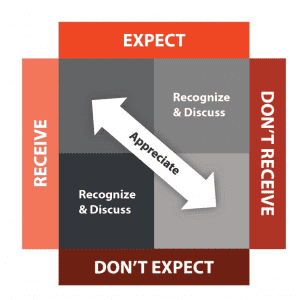“These guys are seasoned managers, and these are fundamental leadership expectations. Shouldn’t they just know the right thing to do?”
“I’m so frustrated, my team is just not executing on what I consider fundamentals.”
“There’s just no accountability here. If someone is going to miss a deliverable why don’t they tell me?”
If any of this sounds familiar, it’s time to revisit your approach to setting and communicating performance expectations.
Defining Your Leadership Expectations
What are your top 3-5 leadership expectations?
Can you pick a few behaviors that matter most and write them down? For example:
I expect you will…
- Spend 70% of your time in the field.
- Have weekly one-on-ones with each of your direct reports.
- Communicate in advance if you’re going to miss a deliverable.
- Meet with your peers to stakeholder ideas before you come to me.
- Come to our meetings on time and fully prepared, having read the materials and ready to make a decision.
3 Ways to Define Your Most Important Expectations
If you have trouble narrowing them down, how do you decide what’s most important?
- Start with what frustrates you. If you’re consistently getting ticked off at your team, that’s a good sign you’ve got a major expectation violation.

2. Think about the behaviors that have made you most successful. Do you have unarticulated expectations that your direct reports will do that too?
3. What behaviors are most important to accomplish your strategic MITs?
Communicating Your Leadership Expectations
Once you’ve identified and written down your leadership expectations it’s time to communicate them to the team.
For each expectation consider how you will communicate and reinforce. A good rule of thumb is five times, five different ways.
For example.
- Meet with team to communicate my top 3 leadership expectations, being sure to connect what I’m asking them to do to why I’m asking them to do it. (e.g. it’s important to spend 70% of your time in the field so you can…. stay in touch with our customer’s pain points and to see first hand what the team needs to provide a truly extraordinary customer experience. (Way 1 = team meeting.)
- Do ride alongs with your team on their field visits and reinforce why the conversations they are having are so important. Celebrate what they are doing right. Coach on ways to improve (Way 2 = ride alongs)
- Send a text to your direct report distribution list asking them for the top three issues they are seeing in their field visits this week (Way 3= text.)
- In your offsite give formal recognition to the manager you’ve observed having the most impactful field visits. Be very clear on what behaviors you are recognizing and have them share their best practices. (Way 4= offsite.)
- In your one-on-one meetings talk about their strategy for field visits–what’s working well, and what they are looking to improve. (Way 5= one-on-ones.)
One good conversation about expectations prevents fourteen “Why didn’t you?” conversations. Taking the time to clearly define and communicate your leadership expectations will save you and your team a great deal of frustration and lost time.
